ISSN ONLINE(2319-8753)PRINT(2347-6710)
ISSN ONLINE(2319-8753)PRINT(2347-6710)
Aasheet Kumar1, Gaurav Chaudhary2, Manish Kalra3, Binit Kumar Jha4
|
| Related article at Pubmed, Scholar Google |
Visit for more related articles at International Journal of Innovative Research in Science, Engineering and Technology
As the customer needs product at higher quality, shorter delivery time, higher customer service level and lower price; companies adopt continuous productivity and quality improvement to survive in the increasingly competitive world market. To cater to this, line balancing and kaizen are effective approaches to improve the productivity and quality. This paper has made use of these approaches to improve the productivity on a Wire Harness Assembly line of a company manufacturing wire harnesses for automobiles. Here, the balance rate has been calculated before and after improvement to show the reduction in manpower requirement and increase in output.
KEYWORDS |
| Kaizen, Assembly Line balancing, Wire harness, Waste reduction, Takt time |
I. INTRODUCTION |
| Kaizen is defined as a cycle of continuous improvements focusing on analysing the performance, brain storming improvement opportunities, implementing improvement and measurement to gauge process, documentation of new standard operating procedure and then repeating the cycle. Continuous improvements require that the company continually strive to be better through learning and problem solving. Because we can never achieve perfection, we must always evaluate our performance and take measures to improve it. |
| Assembly line balancing and sequencing is an active area of optimization research in operations management. The concept of an assembly line came to the fact when the finished product is inclined to the perception of product modularity. Usually interchangeable parts of the final product are assembled in sequence using best possible design of logistics in an assembly line. The initial stage of configuring and designing an assembly line is focused on cost efficient mass production of standardized products. |
| The primary focus of line balancing is minimizing waste related to over production, inventory, defects, transportation, motion, waiting. Assembly line balancing is the only way to achieve that. Principle of inter changeability and division of labour brought about the concept of assembly line, the primary aim of the assembly line was to facilitate mass production, standardisation, simplification and specialisation. Besides, assembly line was also useful in dividing complex work structures into a number of elemental tasks, which would simplify the complex assembly. Assembly line balancing also provides flexibility to the employees, thereby reducing the monotonous activity and thus improving job satisfaction. From the manufacturing point of view, the foremost advantage of assembly line balancing is the ability to keep the direct labour busy doing productive work. Generally an assembly line is designed for high volume production of single item or a family of items. |
| In present day manufacturing, an assembly line can be formed easily for any industry be it small scale or large scale industry. When the takt time are calculated for every assembly operation in the like through different part movements, then the problem of locating required location on the shop floor occurs in all time |
II. LITERATURE REVIEW |
| M. Bala Kumar et al.[1] focused on improving the productivity of a Compressor assembly plant by reducing the cycle time by identifying non-value adding activities on the assembly line and eliminating them using lean tools. Artun Törenli [2] in his thesis analysed the operations and balance losses at the pre-assembly line in a bus production system at MAN Türkiye A.Ãâ¦Ãž. He intended to create a framework for the restructuring process that optimized resource utilization. In the study, an assembly line was observed and analyzed in order to evaluate the balance losses and their reasons. Eventually it was determined which operations were inappropriate for the line and the most evident of them were eliminated. Gautham J. et al. [3] concentrated on improving the overall efficiency of a single model assembly line by reducing the non-value adding activities, cycle time and distribution of work load at each station by line balancing. The methodology they adapted included calculation of process cycle time, identifying non-value adding activities, calculating the total work load on each station and distributing it by line balancing to improve the efficiency of the assembly line. Prashant Uttam Bagal et al. [4] conducted a pilot study of the assembly line to estimate the line imbalance, which was further followed by waste identification, waste elimination and de-bottlenecking of the line to optimize the utilization of resources. Layout was modified to switch from batch and queue system to single piece flow. Sarvesh Kumar Srivastava et al. [5] developed a low cost automation system using a lean tool Kaizen i.e. continuous improvement. It is then seen how low cost automation in manufacturing industry is useful for productivity improvement, fatigue reduction and reduction the chances of injury. |
III. PROBLEM DEFINITION |
| High productivity is what we seek in an assembly line; hence we need to determine the optimum amount of resources in terms of workstation and labour. One method of having a higher productivity assembly line is to use line balancing. Line balancing tool can help to characterize line capacity and take into account the dynamic behaviour of the system. Line balancing can also assist in implementing changes in a quick and effective manner. It is also able to evaluate and optimize the line throughput, machine utilisation and cycle time. This work deals with the end to end perspective of reducing waste at a wire harness assembly line of a manufacturing company. This study is done in wire harness assembly line.Workers are moving all the time to search for tools and materials. This occurs mainly due to keeping resources far away from the work place. |
| The purpose of assembly line balancing is: |
| 1. Increase productivity by eliminating waste and reducing variation |
| 2. Standardize the improvement method and develop it globally |
| 3. Train personnel that are able to find and improve problems by themselves |
| During assembly, various losses are observed. The losses are caused due to: |
| 1. Line unbalance |
| 2. Deviation |
| They are graphically shown below in figure 1. |
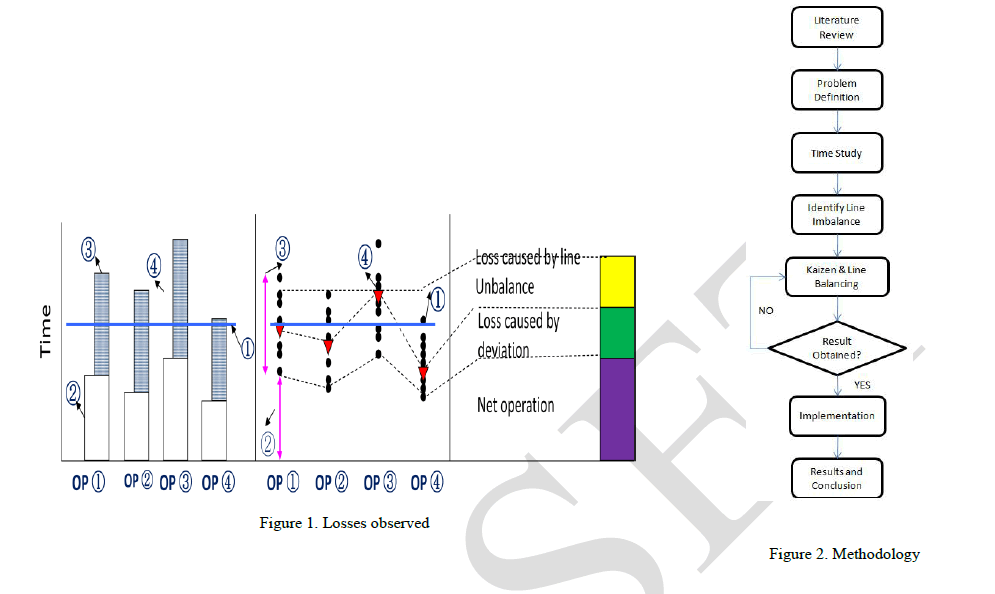 |
IV. METHODOLOGY APPLIED |
| For implementing the line balancing and kaizen in wire harness assembly, the sequence of process and methodology is explained in the figure 2 and table 1. |
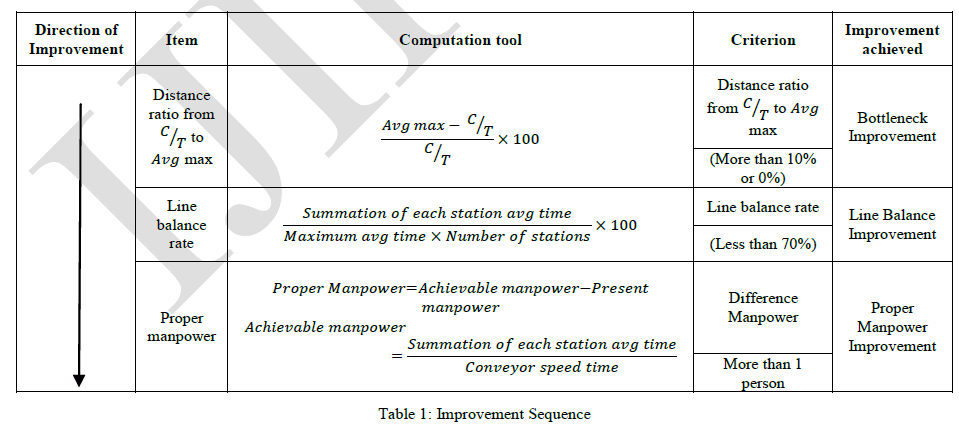 |
| TAKT TIME |
| It sets the pace for industrial manufacturing lines so that production cycle times can be matched to customer demand rate. In practice, it is generally understood that cycle time needs to be slightly less than takt time. |
 |
| LINE BALANCE RATE (LBR) |
| The line balance rate (LBR), and the related line balance loss rate (which is simply 100% minus the LBR), quantifies how well or poorly the line is balanced. |
 |
V. EXPERIMENTAL RESULTS |
| The process of wire harness assembly requires various processing stations like sub-assembly, final assembly, clamping, circuit, part fitting etc. A pictorial representation has been shown in figure 3. |
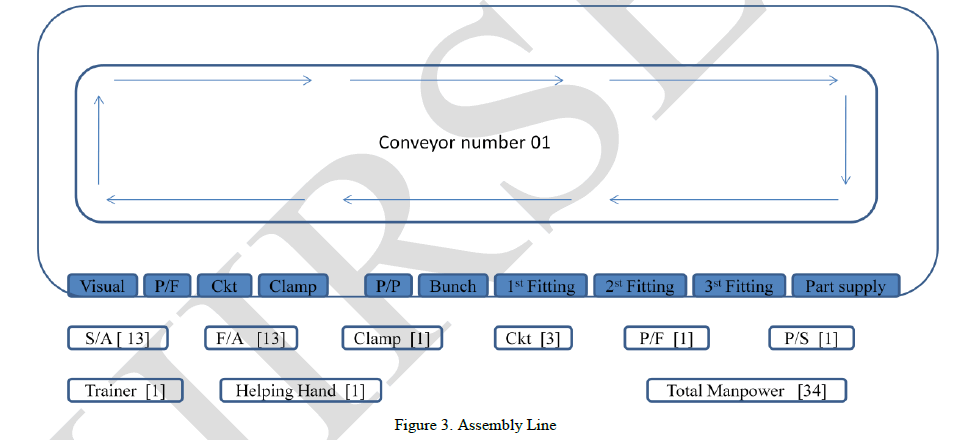 |
| A. PRESENT STATUS |
| For various activities the time has been calculated by using stopwatch. The time required by each processing station is shown in figure 4. |
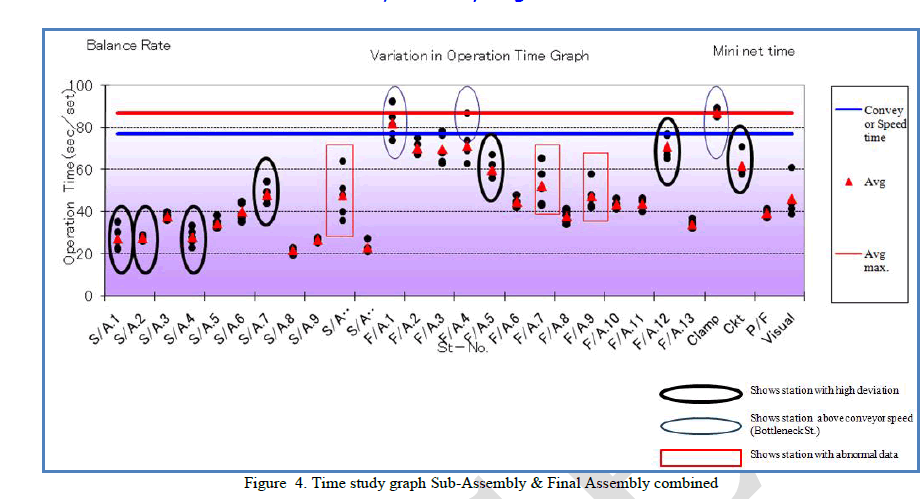 |
| During time study following is identified: |
| 1. Improvement is required for balance rate. |
| 2. Total numbers of kaizen identified (to be implemented) are 32, distributions are shown in figure 5 |
| 3. Maximum time is wasted in crossing of wire & during the mounting of the assembly. |
 |
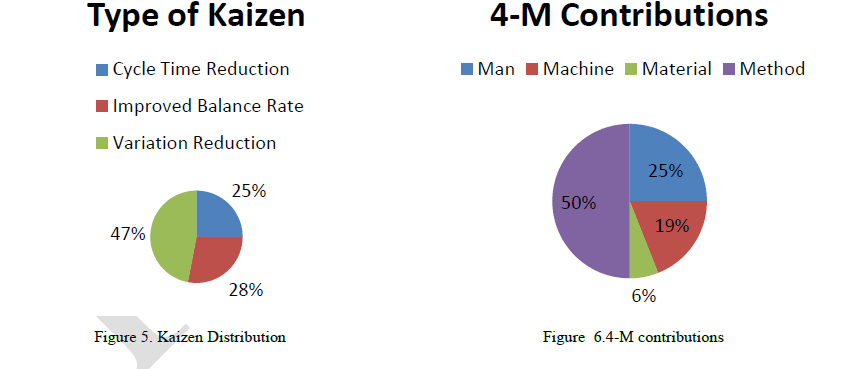 |
| B. AFTER STUDY AND IMPROVEMENT THROUGH LINE BALANCING AND KAIZEN |
| During the assembly process, two types of assemblies are done: |
| 1. Sub-Assembly |
| 2. Final Assembly |
| For each of them, time study is represented in tabular and graphical form in table 2, figure 7 and table 3, figure 8 respectively. |
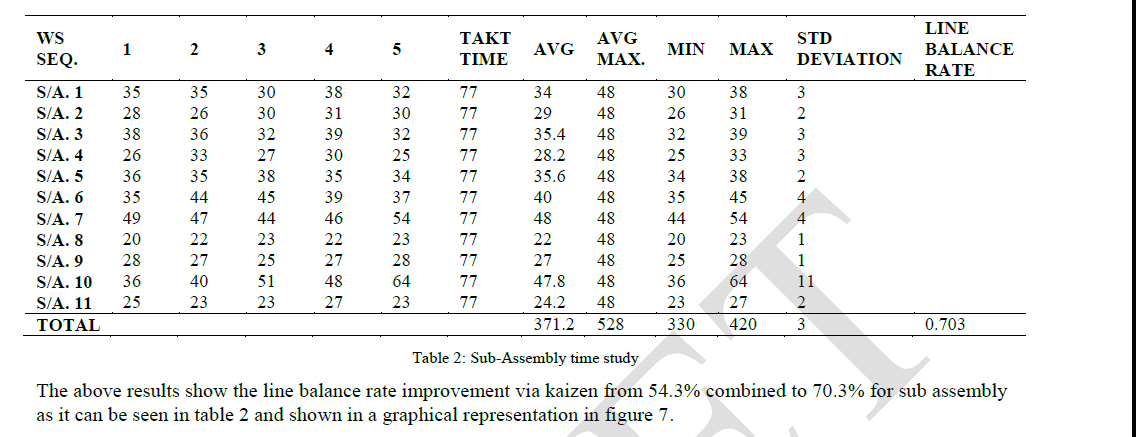 |
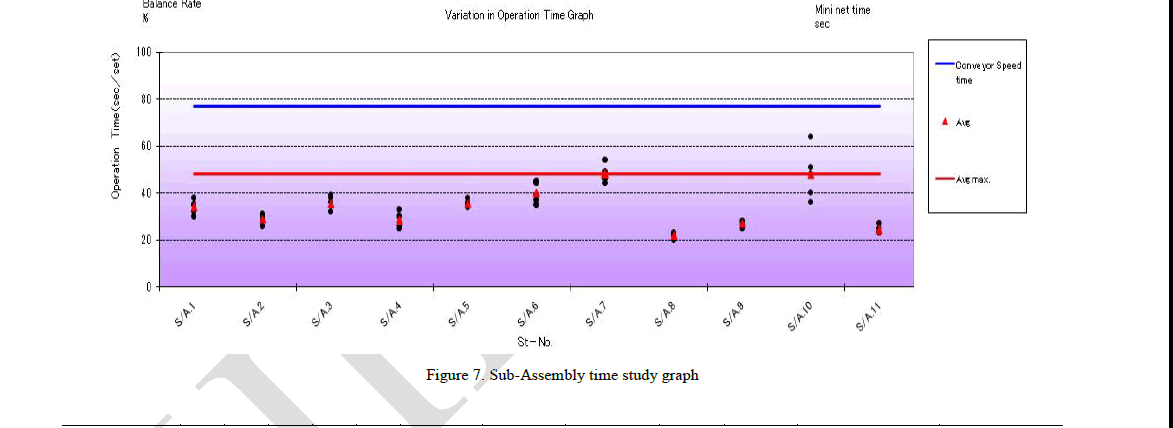 |
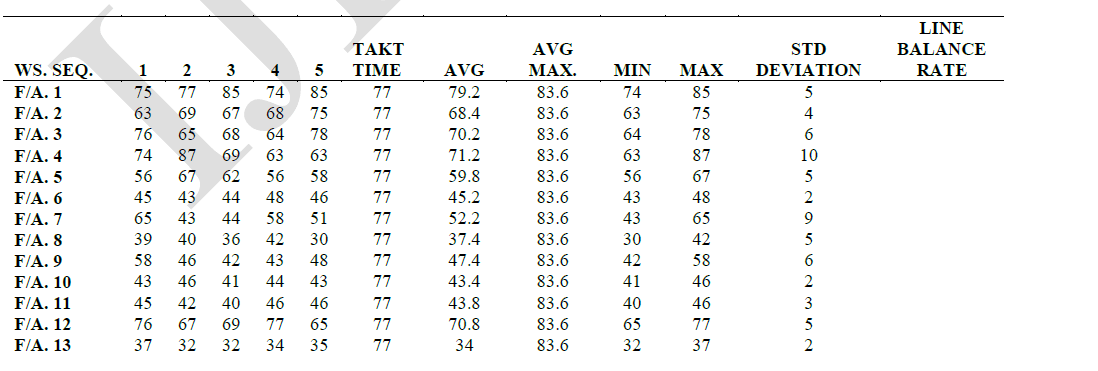 |
 |
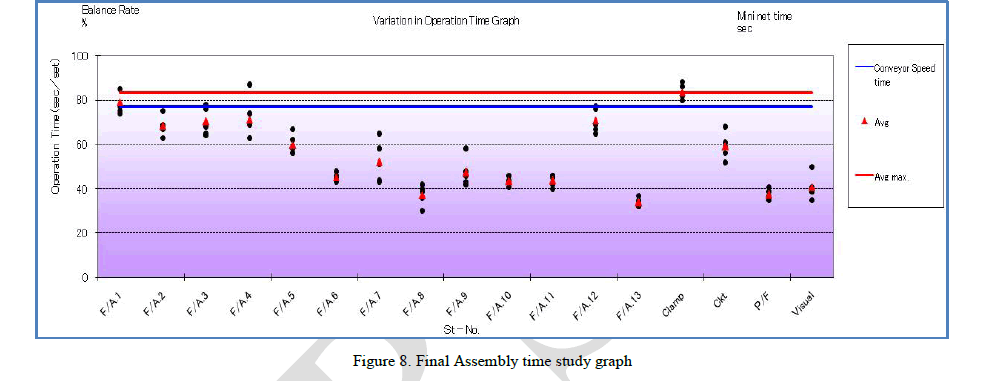 |
VI. ACKNOWLEDGEMENT |
| We are grateful to M/S Motherson Sumi Systems Ltd. (MSSL), NOIDA for supporting us and allowing us to conduct the experiments at their facility. |
VII. CONCLUSION |
| 1. The balance rate calculated for present status is found to be 54.3% for both Sub-Assembly and Final Assembly combined. |
| 2. The balance rate calculated after the implementation of Line Balancing and Kaizen is found to be 70.4% for Sub-Assembly and 66.4% for Final Assembly. |
| 3. As a result a greater extent of line balancing has been achieved. |
| 4. Due to improvement in balance rate, the needed manpower has been reduced by increasing the output from a single assembly line. |
References |
|